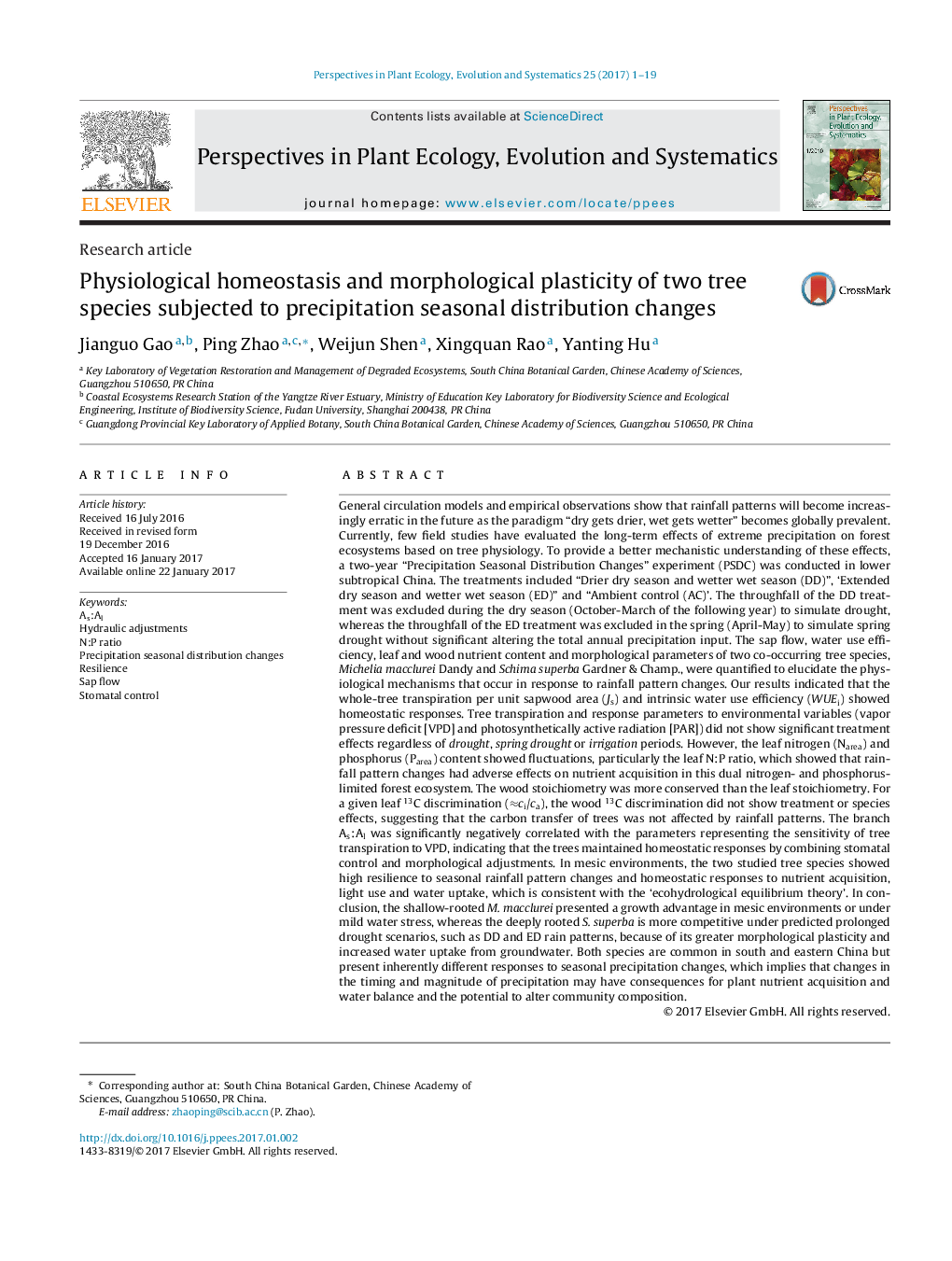| کد مقاله | کد نشریه | سال انتشار | مقاله انگلیسی | نسخه تمام متن |
|---|---|---|---|---|
| 5744969 | 1618595 | 2017 | 19 صفحه PDF | دانلود رایگان |
- “Precipitation Seasonal Distribution Changes” experiment was conducted.
- Two tree species showed homeostatic responses to rainfall pattern changes.
- Trees maintained homeostasis by stomatal control and morphological adjustments.
- S. superba was more competitive under predicted prolonged drought scenarios.
General circulation models and empirical observations show that rainfall patterns will become increasingly erratic in the future as the paradigm “dry gets drier, wet gets wetter” becomes globally prevalent. Currently, few field studies have evaluated the long-term effects of extreme precipitation on forest ecosystems based on tree physiology. To provide a better mechanistic understanding of these effects, a two-year “Precipitation Seasonal Distribution Changes” experiment (PSDC) was conducted in lower subtropical China. The treatments included “Drier dry season and wetter wet season (DD)”, 'Extended dry season and wetter wet season (ED)” and “Ambient control (AC)'. The throughfall of the DD treatment was excluded during the dry season (October-March of the following year) to simulate drought, whereas the throughfall of the ED treatment was excluded in the spring (April-May) to simulate spring drought without significant altering the total annual precipitation input. The sap flow, water use efficiency, leaf and wood nutrient content and morphological parameters of two co-occurring tree species, Michelia macclurei Dandy and Schima superba Gardner & Champ., were quantified to elucidate the physiological mechanisms that occur in response to rainfall pattern changes. Our results indicated that the whole-tree transpiration per unit sapwood area (Js) and intrinsic water use efficiency (WUEi) showed homeostatic responses. Tree transpiration and response parameters to environmental variables (vapor pressure deficit [VPD] and photosynthetically active radiation [PAR]) did not show significant treatment effects regardless of drought, spring drought or irrigation periods. However, the leaf nitrogen (Narea) and phosphorus (Parea) content showed fluctuations, particularly the leaf N:P ratio, which showed that rainfall pattern changes had adverse effects on nutrient acquisition in this dual nitrogen- and phosphorus- limited forest ecosystem. The wood stoichiometry was more conserved than the leaf stoichiometry. For a given leaf 13C discrimination (âci/ca), the wood 13C discrimination did not show treatment or species effects, suggesting that the carbon transfer of trees was not affected by rainfall patterns. The branch As:Al was significantly negatively correlated with the parameters representing the sensitivity of tree transpiration to VPD, indicating that the trees maintained homeostatic responses by combining stomatal control and morphological adjustments. In mesic environments, the two studied tree species showed high resilience to seasonal rainfall pattern changes and homeostatic responses to nutrient acquisition, light use and water uptake, which is consistent with the 'ecohydrological equilibrium theory'. In conclusion, the shallow-rooted M. macclurei presented a growth advantage in mesic environments or under mild water stress, whereas the deeply rooted S. superba is more competitive under predicted prolonged drought scenarios, such as DD and ED rain patterns, because of its greater morphological plasticity and increased water uptake from groundwater. Both species are common in south and eastern China but present inherently different responses to seasonal precipitation changes, which implies that changes in the timing and magnitude of precipitation may have consequences for plant nutrient acquisition and water balance and the potential to alter community composition.
164
Journal: Perspectives in Plant Ecology, Evolution and Systematics - Volume 25, April 2017, Pages 1-19
